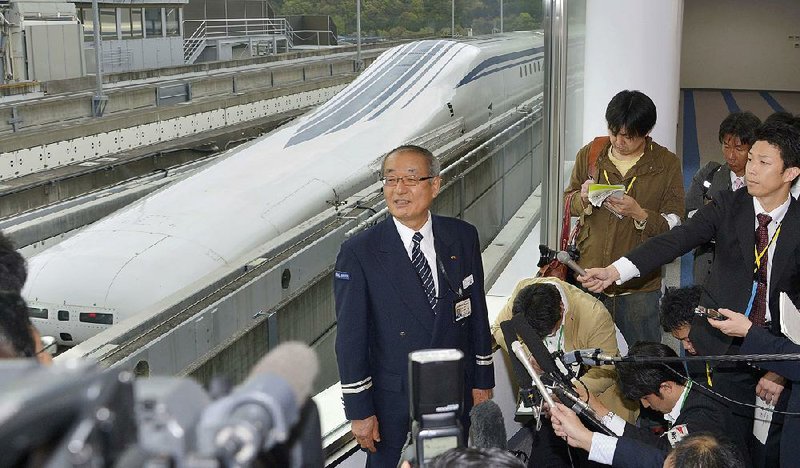TOKYO -- Japan's faded economic prowess received a boost after a magnetic-levitation train operated by Central Japan Railway Co. set a new world speed record of 375 mph on a test run in Yamanashi Prefecture just outside of Tokyo.
Whether any of this makes a shred of economic sense is another matter.
"It's good for growing, developing countries, but not for Japan that's decreasing in population," said Edwin Merner, president of Atlantis Investment Research Corp. in Tokyo. "It's misallocation of resources. Demand for bullet trains will be limited."
Japan, which faces intense competition from China and France in the global market for high-speed rail transport, hasn't found any takers for its "maglev" technology overseas despite an aggressive marketing effort by Prime Minister Shinzo Abe, who has staked his premiership on reviving Japan's economic dynamism.
Japan has plans to build its high-speed maglev line from Tokyo to Nagoya and Osaka. The segment between Tokyo and Nagoya is expected to be ready by 2027 at a cost of $46 billion, with Osaka being connected by 2045 at an overall project cost of $76 billion.
The next-generation train technology relies on magnetic power to float the cars above ground, eliminating the friction of steel tracks. The trains start off running on wheels until they're going fast enough for the magnets to kick in and create lift.
In theory, maglev train technology could redefine city-to-city travel in dramatic ways. The 4,200-kilometer journey from New York to San Francisco, with no stops, could be covered in seven hours at this speed. A London-Paris journey, one of the world's most popular high-speed train routes, would take 50 minutes, less than a quarter of the current time.
Abe, who headed to the United States for an official visit Sunday, has said that his government may provide financing to support a bid by JR Central, as the company is also called, to provide trains for a proposed Washington-Baltimore line.
The Northeast Maglev, a company based in Washington, D.C., is exploring the creation of a maglev system with JR Central in one of the most congested transportation regions in the country. No formal agreements have been reached.
Concerns about high construction costs and uncertain demand have spawned resistance to plans for high-speed rails in the U.S. and Britain.
California is struggling to lay tracks for an $86 billion high-speed line after Congress cut off funds for such projects. The California High-Speed Rail Authority has also been working to settle lawsuits challenging the project.
The British government also faced resistance to plans for a high-speed link between London and Birmingham, scheduled to open in 2026 before being extended to Manchester and Leeds. The U.K. Institute of Directors has called on the government to abandon the plans, arguing that its $74 billion price tag is too steep.
Even in Japan, it is unclear the heavy investment in a maglev system will pay off, given the nation's demographic trends. Japan's population may fall to as 117 million by 2027 from 127 million now, according to projections by the National Institute of Population and Social Security Research. By 2060, the overall population may drop to 80 million.
Worldwide, two maglev lines are already operating. In Shanghai, a train built with technology developed by Siemens and ThyssenKrupp whisks passengers along at 268 mph from Pudong International Airport to the outskirts of the city's financial district.
In Japan, a low-speed version called Linimo, with a top speed of 62 mph, started operations on an 5.5-mile track in Nagoya in 2005.
The biggest rail project up for grabs at the moment doesn't rely on maglev technology. China's top trainmaker, CSR Group, is going head-to-head with European rivals such as Alstom SA in bidding for a range of contracts including rolling stock for Britain's High Speed 2 rail line.
Information for this article was contributed by Benjamin Katz and Christopher Jasper of Bloomberg News.
SundayMonday Business on 04/27/2015
